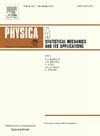Influence of initiators on the tipping point in the extended Watts model
IF 2.8
3区 物理与天体物理
Q2 PHYSICS, MULTIDISCIPLINARY
Physica A: Statistical Mechanics and its Applications
Pub Date : 2024-09-24
DOI:10.1016/j.physa.2024.130123
引用次数: 0
Abstract
In this paper, we study how the influence of initiators (seeds) affects the tipping point of information cascades in networks. We consider an extended version of the Watts model, in which each node is either active (i.e., having adopted an innovation) or inactive. In this extended model, the adoption threshold, defined as the fraction of active neighbors required for an inactive node to become active, depends on whether the node is a seed neighbor (i.e., connected to one or more initiators) or an ordinary node (i.e., not connected to any initiators). Using the tree approximation on random graphs, we determine the tipping point, at which the fraction of active nodes in the final state increases discontinuously with an increasing seed fraction. The occurrence of a tipping point and the scale of cascades depend on two factors: whether a giant component of seed neighbors is formed when the seed fraction is large enough to trigger cascades among seed neighbors, and whether the giant component of ordinary nodes is maintained when newly activated nodes trigger further activations among ordinary nodes. The coexistence of two giant components suggests that a tipping point can appear twice. We present an example demonstrating the existence of two tipping points when there is a gap between the adoption thresholds of seed neighbors and ordinary nodes. Monte Carlo simulations clearly show that the first cascade, occurring at a small tipping point, occurs in the giant component of seed neighbors, while the second cascade, occurring at a larger tipping point, extends into the giant component of ordinary nodes.
扩展瓦特模型中启动器对临界点的影响
本文研究了发起者(种子)的影响力如何影响网络中信息级联的临界点。我们考虑了沃茨模型的扩展版本,其中每个节点要么是活跃的(即采用了创新),要么是不活跃的。在这个扩展模型中,采用阈值被定义为不活跃节点变得活跃所需的活跃邻居的分数,它取决于该节点是种子邻居(即与一个或多个发起者相连)还是普通节点(即与任何发起者都不相连)。利用随机图上的树状近似,我们确定了临界点,在临界点上,最终状态中活跃节点的比例会随着种子比例的增加而不连续地增加。临界点的出现和级联的规模取决于两个因素:当种子分数大到足以引发种子邻居之间的级联时,是否会形成种子邻居的巨大分量;当新激活的节点引发普通节点之间的进一步激活时,是否会维持普通节点的巨大分量。两种巨型成分的共存表明,临界点可能会出现两次。我们举例说明,当种子邻居和普通节点的采用阈值之间存在差距时,就会出现两个临界点。蒙特卡洛模拟清楚地表明,在小临界点出现的第一次级联发生在种子邻居的巨大分量中,而在较大临界点出现的第二次级联延伸到普通节点的巨大分量中。
本文章由计算机程序翻译,如有差异,请以英文原文为准。
求助全文
约1分钟内获得全文
求助全文
来源期刊
CiteScore
7.20
自引率
9.10%
发文量
852
审稿时长
6.6 months
期刊介绍:
Physica A: Statistical Mechanics and its Applications
Recognized by the European Physical Society
Physica A publishes research in the field of statistical mechanics and its applications.
Statistical mechanics sets out to explain the behaviour of macroscopic systems by studying the statistical properties of their microscopic constituents.
Applications of the techniques of statistical mechanics are widespread, and include: applications to physical systems such as solids, liquids and gases; applications to chemical and biological systems (colloids, interfaces, complex fluids, polymers and biopolymers, cell physics); and other interdisciplinary applications to for instance biological, economical and sociological systems.

 求助内容:
求助内容: 应助结果提醒方式:
应助结果提醒方式:


